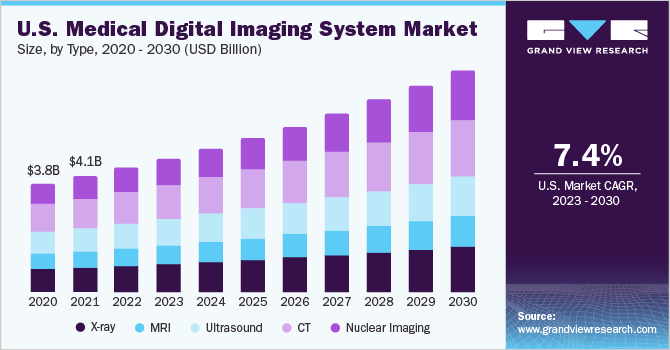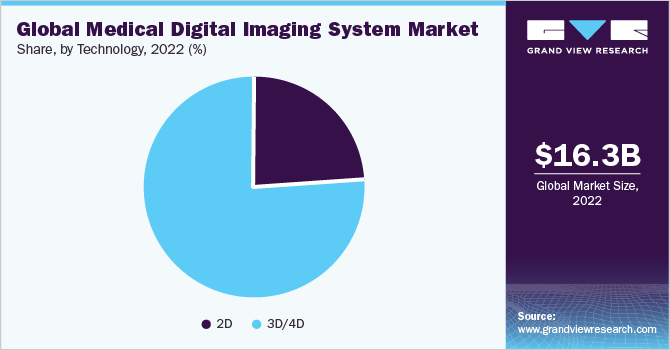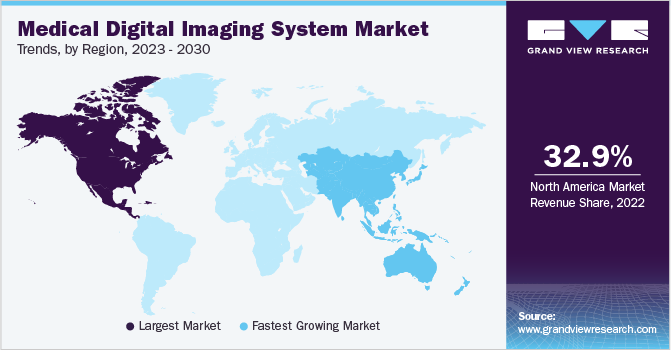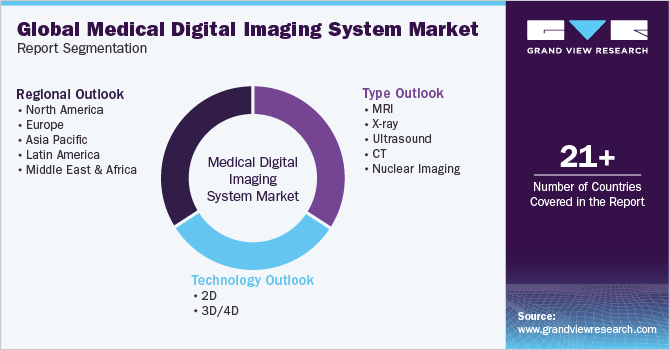- Home
- »
- Medical Devices
- »
-
Medical Digital Imaging System Market Size Report, 2030GVR Report cover
![Medical Digital Imaging System Market Size, Share & Trends Report]()
Medical Digital Imaging System Market Size, Share & Trends Analysis Report By Type (X-ray, MRI, Ultrasound, CT, Nuclear Imaging), By Technology (2D, 3D/4D), By Region, And Segment Forecasts, 2023 - 2030
- Report ID: GVR-1-68038-054-5
- Number of Report Pages: 105
- Format: PDF, Horizon Databook
- Historical Range: 2018 - 2021
- Forecast Period: 2023 - 2030
- Industry: Healthcare
Report Overview
The global medical digital imaging system market size was valued at USD 16.3 billion in 2022 and is expected to grow at a compound annual growth rate (CAGR) 8.2% from 2023 to 2030. Surging demand for effective early diagnostic methods and widening base of aging population have been instrumental in driving the market. Technological advancements and increasing investments and funds by governments, especially in developing countries such as India and China, are also poised to stoke the growth of the market over the coming years. Advancements in digital and communication technologies are have been augmenting the market. New imaging techniques provide accurate anatomical detail in most diagnostic radiology procedures. This has helped in expansion of application of medical digital imaging in exploratory surgery.

Positron emission tomography (PET)/computed tomography (CT) enable determination of metabolic information of PET and anatomic detail of CT simultaneously. High-resolution CT offers images with higher spatial resolution. Magnetic resonance imaging (MRI) is replacing older techniques such as CT, myelography, angiography, and arthrography.
In addition, advancements in digital imaging offer various clinical and economic benefits, such as instant access to radiology studies, lesser risk of data damage, and theft. Automation in procedures help in decreasing waiting time, thus, maximizing efficiency and returns on investment. These benefits help offset costs of equipment and infrastructure.
Type Insights
Computed tomography accounted for the largest share market share of 25.20% in 2022. Nuclear imaging is anticipated to be the fastest growing segment during the forecast period. Development of new radiotracers, increasing prevalence of cancers and cardiovascular diseases, and introduction of new products through advancements are working in favor of the overall market.
According to the American Cancer Society, 1,762,450 new cancer cases weere reported in the U.S. in 2019. Development of radiotracers, such as Single Photon Emission Computed Tomography (SPECT) with technetium 99m radiotracers, which optimizes image quality with reduced radiation exposure, is estimated to contribute to the growth of the CT segment during the forecast period.
Technology Insights
3D/4D technology captured the largest share of 76.20% in 2022. The 3D technology is expected to witness the highest adoption rate in developed as well as developing regions. 2D has been further divided into black and white (BnW) and color.

Technological advancements in 3D/4D imaging technology help in accurate and efficient real-time visualization of human body, thereby minimizing distortion for patients. 4D imaging is 3D with real time movement. The global market for 3D and 4D devices is likely to experience lucrative growth in the forecast period owing to increasing adoption of these technologies such as fetal monitoring.
Regional Insights
North America dominated the market in 2022 with market share of 32.88% owing to high adoption of advanced technology and improved healthcare infrastructure, high purchasing power, and favorable reimbursement framework.

Asia Pacific is poised to exhibit the highest CAGR with 10.3% during the forecast period, mainly due to increasing government incentives and lower cost of clinical trials. Healthcare in the region is dominated by private healthcare services providers. Presence of international service provider companies such as Wockhardt Hospitals, Columbia Asia, and Fortis Healthcare is projected to boost level of competition in the private sector. Rapid growth in the medical tourism is anticipated to fuel the demand for advanced diagnostic methods in this highly competitive market.
Key Companies & Market Share Insights
Some of the key players are Siemens Healthcare, Hitachi, GE Healthcare, Koninklijke Philips, Canon Medical Systems Corporation, Hologic, Medtronic, and Shimadzu Corporation. Regional and service portfolio expansions and mergers and acquisitions are among the key strategies adopted by these players to gain a higher share.
In July 2022, Siemens Healthineers. introduced The Mobilett Impact (Mobile X-ray System). The system is a combination of full digital integration, an affordable price, and all the advantages of mobile X-ray equipment for imaging at the patient's bedside. Mobile x-ray is essential for situations where the patient cannot leave the bed or be taken to the radiology department.Some of the prominent players in the global medical digital imaging system market include:
-
Koninklijke Philips N.V
-
GE Healthcare
-
Siemens Healthineers
-
Esaote SPA
-
Canon Medical Systems Corporation
-
Hologic
-
Hitachi
-
Shimadzu
Medical Digital Imaging System Market Report scope
Report Attribute
Details
Market size value in 2023
USD 17.6 billion
Revenue forecast in 2030
USD 30.5 billion
Growth rate
CAGR of 8.2% from 2023 to 2030
Base year for estimation
2022
Historical data
2018 - 2021
Forecast period
2023 - 2030
Report updated
July 2023
Quantitative units
Revenue in USD billion, and CAGR from 2023 to 2030
Report coverage
Revenue forecast, company share, competitive landscape, growth factors & trends
Segments covered
Type, technology, region
Regional scope
North America; Europe; Asia Pacific; Latin America; MEA
Country scope
U.S., Canada, UK, Germany, China, Japan, Brazil, Mexico, Chile, South Africa, Saudi Arabia.
Key companies profiled
Koninklijke Philips N.V; GE Healthcare; Siemens Healthineers; Esaote SPA; Canon Medical Systems Corporation; Hologic; Hitachi; Shimadzu
Customization scope
Free report customization (equivalent up to 8 analysts working days) with purchase. Addition or alteration to country, regional & segment scope.
Pricing and purchase options
Avail customized purchase options to meet your exact research needs. Explore purchase options.
Global Medical Digital Imaging System Market Report Segmentation
This report forecasts revenue growth at global, regional & country levels and provides an analysis on the latest trends and opportunities in each of the sub-segments from 2018 to 2030. For the purpose of this study, Grand View Research has segmented the global digital medical imaging system market report on the basis of type, technology, and region:

-
Type Outlook (Revenue, USD Million, 2018 - 2030)
-
MRI
-
X-ray
-
Ultrasound
-
CT
-
Nuclear Imaging
-
-
Technology Outlook (Revenue, USD Million, 2018 - 2030)
-
2D
-
BnW
-
Color
-
-
3D/4D
-
-
Regional Outlook (Revenue, USD Million, 2018 - 2030)
-
North America
-
U.S.
-
Canada
-
-
Europe
-
Germany
-
UK
-
-
Asia Pacific
-
China
-
Japan
-
-
Latin America
-
Brazil
-
Mexico
-
Chile
-
-
MEA
-
South Africa
-
Saudi Arabia
-
-
Frequently Asked Questions About This Report
b. The global medical digital imaging system market size was estimated at USD 16.3 billion in 2022 and is expected to reach USD 17.6 billion in 2023.
b. The global medical digital imaging system market is expected to grow at a compound annual growth rate of 8.2% from 2023 to 2030 to reach USD 30.5 billion by 2030.
b. CT dominated the medical digital imaging systems market with a share of 25.2% in 2022. This is attributable to the frequent introduction of advanced products.
b. Some key players operating in the medical digital imaging system market include Siemens Healthcare, Hitachi, GE Healthcare, Koninklijke Philips, Canon Medical Systems Corporation, Hologic, Medtronic, and Shimadzu Corporation.
b. Key factors that are driving the medical digital imaging system market growth include surging demand for effective early diagnostic methods and a widening base of the aging population.
Share this report with your colleague or friend.
![gvr icn]()
NEED A CUSTOM REPORT?
We can customize every report - free of charge - including purchasing stand-alone sections or country-level reports, as well as offer affordable discounts for start-ups & universities. Contact us now
![Certified Icon]()
We are GDPR and CCPA compliant! Your transaction & personal information is safe and secure. For more details, please read our privacy policy.
We are committed towards customer satisfaction, and quality service.
"The quality of research they have done for us has been excellent."





